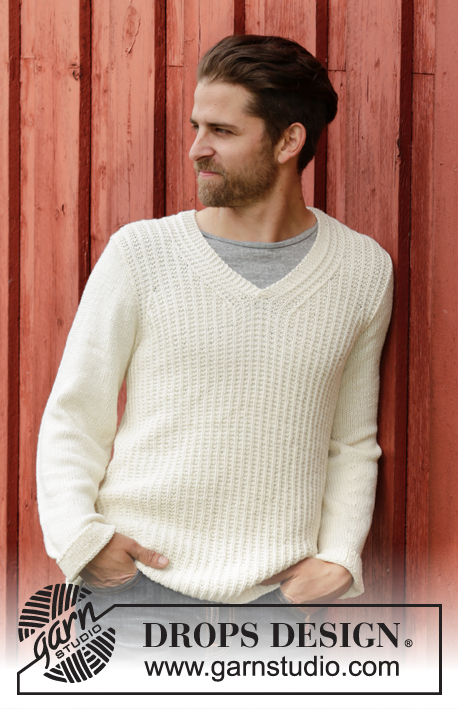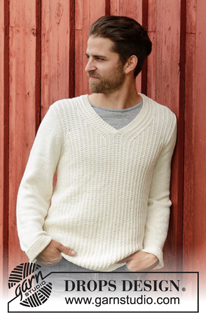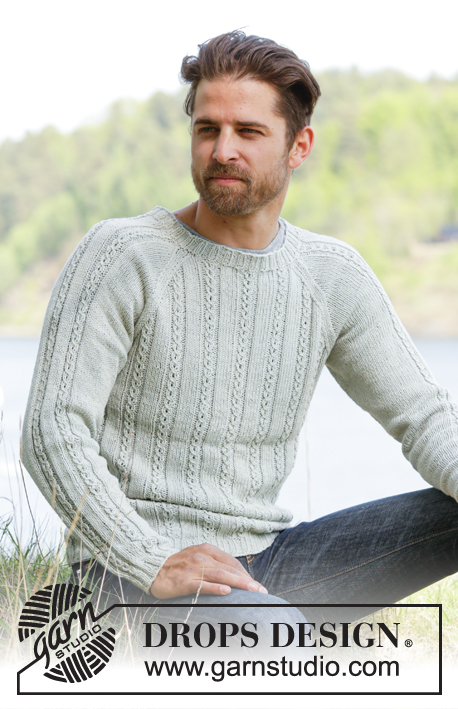Comments / Questions (68)
![]() Karine Dreiak wrote:
Karine Dreiak wrote:
Ma ei saa aru kuidas paremat hõlma edasi kududa, kui 5 silma on tagant võetud. Kuidas jätkata kudumist nende 5 silmusega ja nendega mis on juba olemas vardal?
20.06.2020 - 08:11DROPS Design answered:
Tere Karine! Kootakse edasi-tagasi nagu vasakut õlga. Need 5 silmust moodustavad kaelusekandi, mille otsad jäävad teineteise taha kaelaugu all kolmurgas. Head kudumist!
01.07.2020 - 23:57
![]() Nat Halie wrote:
Nat Halie wrote:
Vous avez fait une erreur pour l'encolure il ne faut pas prendre 2 mailles plus la maille du milieu mais il faut prendre la maille du milieu et 1 seule maille sinon ce n'est pas équilibré
24.02.2020 - 19:16
![]() Jill Lendrum wrote:
Jill Lendrum wrote:
The "correction" to this pattern is still wrong. Knitting S size, FRONT, dividing for the V, there should surely be no decreases at the armhole side? Otherwise one is left with 13 and not 28 sts per shoulder. Please confirm.
21.02.2020 - 23:35DROPS Design answered:
Dear Mrs Lendrum, in size S you have 49 sts for left front piece, decrease 6 sts for armhole and decrease 15 sts for neck = 49-6-15= 28 sts remain for shoulder. Happy knitting!
24.02.2020 - 10:35
![]() Nat Halie wrote:
Nat Halie wrote:
On diminue les emmanchures sur l'endroit mais cela décale le point A 1 sur l'envers Comment doit on faire ?
19.02.2020 - 15:21DROPS Design answered:
Bonjour Nat Halie, vous ne devez pas décaler A.1, les mailles de chaque côté des emmanchures vont "disparaître" (= diminutions) mais les autres vont continuer à se tricoter comme avant = les mailles point mousse au point mousse (ex1ère ou dernière m de A.1) et en jersey (ex 2ème, 5ème ou 8ème m de A.1). Autrement dit, tricotez les 7 premières et 7 dernières mailles comme avant, et tricotez les autres mailles comme avant en A.1 - ajustez pour que le motif continue en hauteur. Bon tricot!
19.02.2020 - 16:13
![]() Parvin Padham wrote:
Parvin Padham wrote:
HI I want to know is a pattern worked all in one back and front until the armhole?
17.01.2020 - 13:59DROPS Design answered:
Dear Mrs Padham, yes correct, you work jumper bottom up first in the round until armholes, then front and back piece will be worked back and forth separately. Sleeves are then worked (first in the round until sleeve cap then back and forth to the end) afterwards and sewn into armholes. Happy knitting!
17.01.2020 - 14:19
![]() Courrier wrote:
Courrier wrote:
Bonjour, Je ne comprends pas au niveau des diminutions de l\'encolure. En effet, je fais une taille L, j'ai donc 87 m. Il m'est demandé de mettre 46 m d'un côté (43 + m avec le marqueur + 2 m) et 41 m en attente. Pourtant dès deux côtés j'ai le même nombre de diminution. Donc si je réduis 18 fois 1 m de chaque côté j'aurai 28 m d'un côté et 23 m de l'autre... Est-il normal que ça soit asymétrique? Merci pour votre réponse
27.11.2019 - 23:20DROPS Design answered:
Bonjour Mme Courrier, quand vous ferez le devant droit, vous allez relever 5 m derrière la bordure du devant gauche, vous aurez ainsi le même nombre de mailles pour les deux devants. Bon tricot!
28.11.2019 - 10:03
![]() Annie Heida wrote:
Annie Heida wrote:
Ik brei maat xl. 117 st. Met het linker voorpand kom ik goed uit. Maar met rechtervoorpand neem je 5 extra steken op aan de achterkant van het linker voorpand. En daar ligt mijn vraag, dan heb je dus 5 st meer. Dus uiteindelijk blijven er dan 33 st over op de schouder i.p.v. 28st. Mvg Annie Heida
11.04.2019 - 19:45DROPS Design answered:
Dag Annie,
Voordat je het linker voorpand breit, plaats je een markeerdraad in de middelste steek op het voorpand. Bij het breien van het linker voorpand heb je de middelste steek met de markeerdraad ook op de naald + 2 steken daarnaast. Er zit dus een overlap in.
16.04.2019 - 13:58
![]() Annie Heida wrote:
Annie Heida wrote:
Hallo, Bedankt voor de reactie. Maar ik begrijp het nog niet helemaal. Want je neemt die 5 steken op van achter het linker voorpand en dan heb je totaal 5 steken meer. Ik snap dat het in spiegelbeeld moet. Dus als je op dezelfde manier mindert dan houd ik op het eind 33 st over voor de schouder. En daar ligt het probleem.
10.04.2019 - 22:44DROPS Design answered:
Dag Annie,
Ik weet niet welke maat je breit, maar hier even een rekenvoorbeeld voor de kleinste maat: Je hebt 93 steken op de naald. In de middelste steek daarvan zit de markeerdraad. Als je het werk midden voor verdeeld plus de middelste steek en de 2 steken erna, heb je 49 steken op de naald. Voor de mouw kant je 6 keer 1 steek af = 43 steken. Voor de hals kant je 15 steken af en dan kom je op 28 steken.
11.04.2019 - 15:13
![]() Annie Heida wrote:
Annie Heida wrote:
Hoe zit met de v-hals? Als je 5 steken opneemt aan de achterzijde van het linkervoorpand, hoe minder je deze steken dan.
09.04.2019 - 22:31DROPS Design answered:
Dag Annie,
Je breit het rechter voorpand hetzelfde als het linker voorpand, maar dan in spiegelbeeld. De 5 steken neem je op achter de 5 middelste steken van het linker voorpand en dan minder je voor de hals naast de 11 steken middenvoor, zoals beschreven in het patroon, zodat de v-hals gevormd wordt.
10.04.2019 - 09:17
![]() Annie Heida wrote:
Annie Heida wrote:
Hallo, ik snap niet de minderingen bij de armsgaten. totaal minderen: 6-12-6 st en vervolgens 15 x1. totaal minderen 78 st . of is die 15 x 1 st bedoeld voor de v-hals? mvh, Annie Heida
19.03.2019 - 14:36DROPS Design answered:
Dag Annie,
Aannemende dat je maat XL breit (omdat je het hebt over 15 x 1 st): als je het lijf aan het breien bent en je bent op het punt van de armsgaten, dan kant je 12 steken af onder de armsgaten. Vervolgens brei je de delen apart verder en kant je 15 keer 1 steek af aan beide kanten van beide panden voor de armsgaten. Dit staat los voor het afkanten voor de V-hals.
21.03.2019 - 16:57
Riley#rileysweater |
|||||||
 |
 |
||||||
Knitted men’s jumper with textured pattern and V-neck in DROPS Cotton Merino or DROPS Daisy. Size: S - XXXL.
DROPS 174-22 |
|||||||
|
GARTER ST (in the round on circular needle): * K 1 round and P 1 round *, repeat from *-*. 1 ridge = 2 rounds. PATTERN: See diagram A.1. DECREASE TIP ARMHOLE: Dec inside 7 sts in each side. Dec at beg of row as follows: Work 7 sts as before, slip 1 st as if to K, K next st, psso. Dec at end of row as follows: Work until 9 sts remain, K the next 2 tog, work the last 7 sts as before. DECREASE TIP NECK: All dec are done from RS. Dec inside 11 sts in each side. Dec as follows before band (left front piece). Work until 13 sts remain, K the next 2 tog, work the last 11 sts as before. Dec as follows after band (right front piece). Work 11 sts as before (= band st + 6 sts pattern), slip next st as if to K, K 1, psso. ---------------------------------------------------------- JUMPER: Worked in the round on circular needle. Cast on 198-222-234-258-282-306 sts on circular needle size 3.5 mm with Cotton Merino or DROPS Daisy. K 1 round, on next round work rib over all sts as follows: P 1, * K 1, P 2 *, repeat from *-* the entire round and finish with K 1 and P 1. Work rib for 4 cm. Switch to circular needle size 4 mm and work A.1 over all sts. When piece measures 45-46-47-48-49-50 cm, cast off for armholes in each side as follows: Cast off the first 3-3-3-6-6-6 sts, work 93-105-111-117-129-141 sts, cast off the next 6-6-6-12-12-12 sts, work 93-105-111-117-129-141 sts, cast off the last 3-3-3-6-6-6 sts. Finish front and back piece separately. BACK PIECE: = 93-105-111-117-129-141 sts. Continue with A.1 as before. AT THE SAME TIME on next row from RS continue dec for armholes in each side - dec 1 st in each side every other row 6-12-12-15-18-24 times in total – READ DECREASE TIP ARMHOLE! = 81-81-87-87-93-93 sts. When piece measures 62-64-66-68-70-72 cm, work in garter st over the middle 35-35-41-41-47-47 sts, continue the remaining sts in pattern. When piece measures 64-66-68-70-72-74 cm, cast off the middle 25-25-31-31-37-37 sts for neck = 28 sts remain on each shoulder in all sizes. Cast off when piece measures 66-68-70-72-74-76 cm. FRONT PIECE: = 93-105-111-117-129-141 sts. Insert a marker in the middle st. Continue to dec for armholes as on back piece. When piece measures 54-56-55-55-57-59 cm, keep sts until marker, st with marker and 2 sts after marker on needle, slip the remaining sts on a stitch holder. Now work in GARTER ST – see explanation above, over 5 sts towards mid front (= band), continue with A.1 over the remaining sts as before. Continue with dec for armhole, AT THE SAME TIME dec for neck as follows - READ DECREASE TIP NECK: Dec on every other row 15-15-18-18-21-21 times in total. After all dec for armhole and neck, 28 sts remain on shoulder in all sizes. Cast off when piece measures 66-68-70-72-74-76 cm. RIGHT FRONT PIECE: Slip sts from stitch holder back on needle and pick up 5 sts in garter st at the back of band on left front piece. Work as left front piece. SLEEVE: Worked in the round on double pointed needles. Cast on 54-57-60-60-63-66 sts on double pointed needles size 3.5 mm with Cotton Merino or DROPS Daisy. Insert 1 marker at the beg of round. K 1 round, then work rib = K 1/P 2. When piece measures 4 cm, switch to double pointed needle size 4 mm, continue with stocking st, on 1st round with stocking st dec 4-5-6-4-5-6 sts evenly = 50-52-54-56-58-60 sts on round. When piece measures 8 cm, inc 1 st on each side of marker. Inc every 4½-3-2½-2-2-1½ cm 8-11-12-18-20-22 times in total, then inc every 2 cm 5-5-5-0-0-0 times = 76-84-88-92-98-104 sts. When piece measures 54-53-53-51-51-50 cm (shorter measurements in the larger sizes because of longer sleeve cap and wider shoulders), cast off 6 sts mid under sleeve (= 3 sts on each side of marker) and work sleeve back and forth on circular needle until finished measurements. Cast off for sleeve cap at beg of every row in each side: Cast off 2 sts 5 times and 1 st 2-3-5-6-9-10 times, then cast off 2 sts in each side until piece measures 63-63-64-64-65-65 cm, then cast off 3 sts 1 time in each side. Cast off the remaining sts, piece measures approx. 64-64-65-65-66-66 cm. Knit another sleeve. ASSEMBLY: Sew the shoulder seams. Sew in sleeves. |
|||||||
Diagram explanations |
|||||||
|
|||||||
 |
|||||||
Have you finished this pattern?Tag your pictures with #dropspattern #rileysweater or submit them to the #dropsfan gallery. Do you need help with this pattern?You'll find 21 tutorial videos, a Comments/Questions area and more by visiting the pattern on garnstudio.com. © 1982-2025 DROPS Design A/S. We reserve all rights. This document, including all its sub-sections, has copyrights. Read more about what you can do with our patterns at the bottom of each pattern on our site. |
|||||||

























































Post a comment to pattern DROPS 174-22
We would love to hear what you have to say about this pattern!
If you want to leave a question, please make sure you select the correct category in the form below, to speed up the answering process. Required fields are marked *.